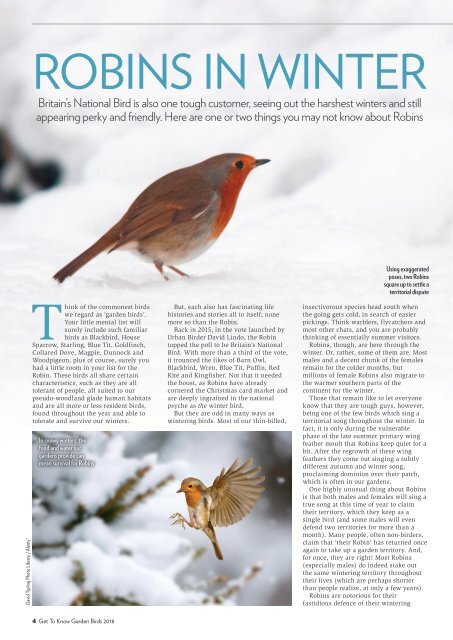You also want an ePaper? Increase the reach of your titles
YUMPU automatically turns print PDFs into web optimized ePapers that Google loves.
ROBINS IN WINTER<br />
Britain’s National Bird is also one tough customer, seeing out the harshest winters and still<br />
appearing perky and friendly. Here are one or two things you may not know about Robins<br />
Using exaggerated<br />
poses, two Robins<br />
square up to settle a<br />
territorial dispute<br />
David Tipling Photo Library / Alamy*<br />
Think of the commonest birds<br />
we regard as ‘garden birds’.<br />
Your little mental list will<br />
surely include such familiar<br />
birds as Blackbird, House<br />
Sparrow, Starling, Blue Tit, Goldfinch,<br />
Collared Dove, Magpie, Dunnock and<br />
Woodpigeon, plus of course, surely you<br />
had a little room in your list for the<br />
Robin. These birds all share certain<br />
characteristics, such as they are all<br />
tolerant of people, all suited to our<br />
pseudo-woodland glade human habitats<br />
and are all more or less resident birds,<br />
found throughout the year and able to<br />
tolerate and survive our winters.<br />
In snowy winters, the<br />
food and water our<br />
gardens provide can<br />
mean survival for Robins<br />
But, each also has fascinating life<br />
histories and stories all to itself; none<br />
more so than the Robin.<br />
Back in 2015, in the vote launched by<br />
Urban Birder David Lindo, the Robin<br />
topped the poll to be Britain’s National<br />
Bird. With more than a third of the vote,<br />
it trounced the likes of Barn Owl,<br />
Blackbird, Wren, Blue Tit, Puffin, Red<br />
Kite and Kingfisher. Not that it needed<br />
the boost, as Robins have already<br />
cornered the Christmas card market and<br />
are deeply ingrained in the national<br />
psyche as the winter bird.<br />
But they are odd in many ways as<br />
wintering birds. Most of our thin-billed,<br />
insectivorous species head south when<br />
the going gets cold, in search of easier<br />
pickings. Think warblers, flycatchers and<br />
most other chats, and you are probably<br />
thinking of essentially summer visitors.<br />
Robins, though, are here through the<br />
winter. Or, rather, some of them are. Most<br />
males and a decent chunk of the females<br />
remain for the colder months, but<br />
millions of female Robins also migrate to<br />
the warmer southern parts of the<br />
continent for the winter.<br />
Those that remain like to let everyone<br />
know that they are tough guys, however,<br />
being one of the few birds which sing a<br />
territorial song throughout the winter. In<br />
fact, it is only during the vulnerable<br />
phase of the late summer primary wing<br />
feather moult that Robins keep quiet for a<br />
bit. After the regrowth of these wing<br />
feathers they come out singing a subtly<br />
different autumn and winter song,<br />
proclaiming dominion over their patch,<br />
which is often in our gardens.<br />
One highly unusual thing about Robins<br />
is that both males and females will sing a<br />
true song at this time of year to claim<br />
their territory, which they keep as a<br />
single bird (and some males will even<br />
defend two territories for more than a<br />
month). Many people, often non-birders,<br />
claim that ‘their Robin’ has returned once<br />
again to take up a garden territory. And,<br />
for once, they are right! Most Robins<br />
(especially males) do indeed stake out<br />
the same wintering territory throughout<br />
their lives (which are perhaps shorter<br />
than people realise, at only a few years).<br />
Robins are notorious for their<br />
fastidious defence of their wintering<br />
4 Get To Know Garden Birds 2018

















